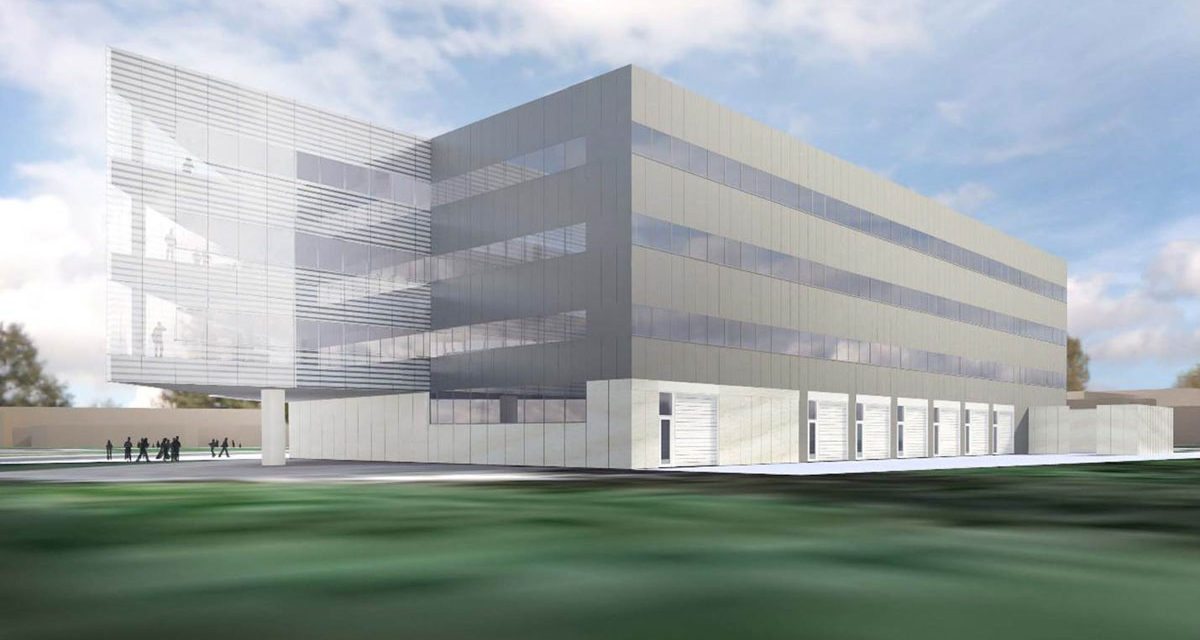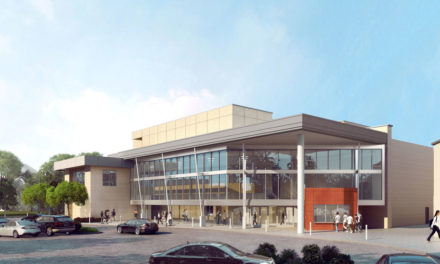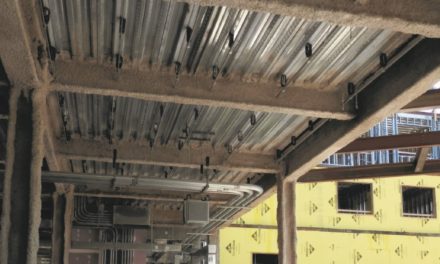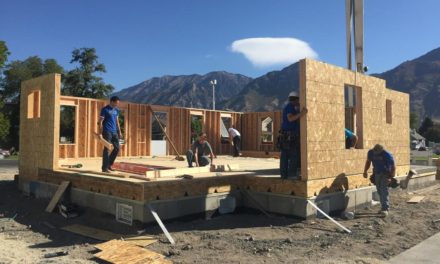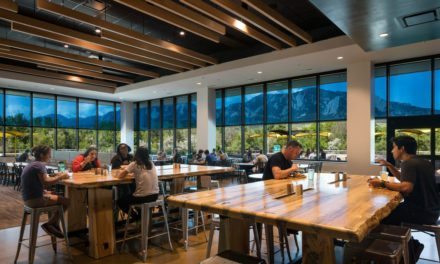Robotic technologies for air, sea and roads, for factories, hospitals and homes will have tailored lab space in the University of Michigan’s planned Robotics Laboratory.
Last month the U-M Board of Regents approved the schematic design for the $75 million facility, which is slated for the northeast corner of North Campus in the College of Engineering.
The 140,000-square-foot building will house a three-story fly zone for autonomous aerial vehicles, an outdoor obstacle course for walking robots, and high-bay garage space for self-driving cars, among other features.
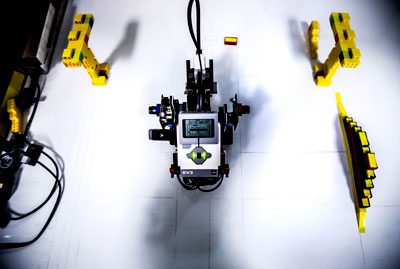
Kira Barton, ME Professor, sets a track for the testing of a robot that uses cooperative algorithms in the HH Dow Building on March 9, 2015. The robot interacts with other robots that are installed with cooperative algorithms that Kira Barton and her research group have designed in hopes of providing a model for larger scale implementation of autonomous vehicles and robots. Photo: Joseph Xu, Michigan Engineering Communications & Marketing
And in a unique collaboration, Ford Motor Co. will provide funding to add a fourth floor that it will lease for dedicated space where Ford researchers will eventually be based. The shared space grows a long-standing and broad partnership between U-M and Ford that includes projects to advance a variety of technologies such as driverless and connected vehicles.
Construction is scheduled to begin after a comprehensive fundraising effort for College of Engineering funds and be completed in winter 2020.
When the building opens, U-M will become one of an elite few universities with a dedicated robotics facility. It will be the only university whose lab is down the road from a proving ground for driverless and connected vehicles. Mcity, U-M’s simulated urban and suburban environment for safe, controlled testing of advanced mobility vehicles and technologies, is located a half mile from the Robotics Laboratory site.
“The University of Michigan has long been a global leader in robotics and our new facility will give our faculty members room to reach for world-changing advances and set them in motion,” said Professor Alec Gallimore, the Robert J. Vlasic Dean of Engineering. “Robots have come a long way from programmed machines bolted to the factory floor. Today they move through the world around us. They communicate and interact with each other and with us. They’re making our work, our travel and our lives easier, more efficient and safer.”
Fifteen professors will be core robotics faculty members when the facility opens, and more than 35 across the university are working in the field. They are developing prosthetic limbs that could one day be controlled by the brain, an autonomous wheelchair that can sense obstacles and avoid them, efficient walking robots that have the potential to assist in search or rescue operations, and self-driving and connected cars designed to transform transportation, among other innovations.
Most of the core faculty members conduct their research on an actual robot, which is unique to U-M.
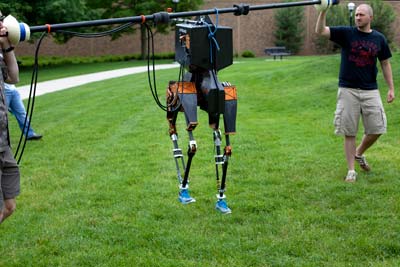
Jessy Grizzle’s robot Marlo walking on the Wave Field at the University of Michigan’s North Campus. Photo by Marcin Szczepanski/Senior Multimedia Producer, University of Michigan, College of Engineering
“What makes us special is that most of us here do both robotics theory and hardware,” said Jessy Grizzle, the Elmer G. Gilbert Distinguished University Professor and the Jerry W. and Carol L. Levin Professor of Engineering.
“Many places with strong robotics reputations are computer science-dominated and they don’t test their theories on machines to the extent that we do. At U-M, most of our faculty members have an in-house robot. We put our algorithms in motion.”
Grizzle has been named director of robotics at U-M. He came to the university in 1987 as a feedback control theorist, but quickly expanded his research into other areas. Among his achievements is the development of a theoretically sound and efficient method for control of bipedal robot locomotion, which resulted in the world’s fastest two-legged running robot with knees.
He was also a key player in pioneering a model-based programming approach to the control of hybrid electric vehicles that is rapidly becoming an industry standard. The approach takes into account the random fluctuations in traffic patterns to make these vehicles as efficient as possible.
“This new facility will give us cutting-edge lab space to test our theories on a broader scale, and in a collaborative environment that invites the exchange of ideas,” Grizzle said.
The building’s schematic design shows a sleek, slate gray and silver façade integrated into the environment in a style described as “machine in the garden.” In addition to the specialized labs, it will include two large shared lab spaces, a startup-style open collaboration area, offices for 30 faculty members and more than 100 graduate students and postdoctoral researchers, and two classrooms. U-M offers interdisciplinary master’s and doctoral degrees in robotics.
A grand atrium will be flanked by glass walls that serve as windows into high-tech labs and a museum for retired robots. Public and school tours will be available.
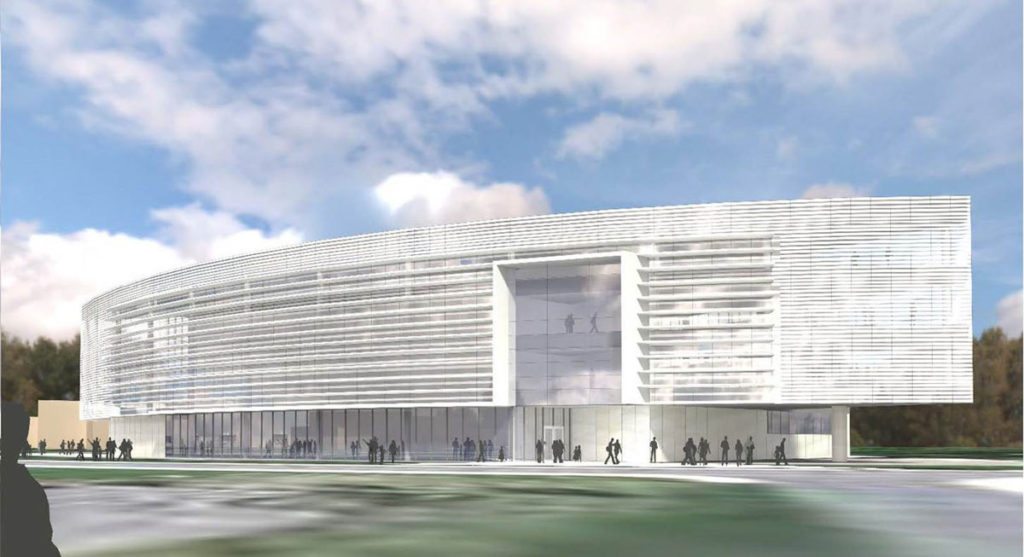
An architectural rendering of the southeast elevation of the planned Robotics Laboratory, which will be built northeast of the Space Research Building on the University of Michigan’s North Campus.
The partnership that puts Ford engineers on the fourth floor is designed to enrich opportunities for collaborative research, as well as provide educational opportunities for students to gain hands-on experiences.
“With the new building’s proximity to Mcity, Ford and U-M are poised to accelerate the development of autonomous vehicles,” said Ken Washington, Ford vice president of research and advanced engineering. “This co-located lab on the U-M campus will magnify and deepen a collaborative research effort that is already unprecedented in scale.”
With a decade-long history, the Ford/U-M Innovation Alliance has led to nearly 200 collaborative research projects. Its joint autonomous vehicle project is the largest university research effort Ford has sponsored on any campus, and the largest industry-funded individual research project at U-M. The technical innovations Ford and U-M produce through it are intended to deliver order of magnitude reductions in traffic deaths and collisions.
The robotics building project is expected to provide an average of 66 onsite construction jobs.
Also see Robotics at Michigan, Ford news release, Images and Robotics video playlist.

